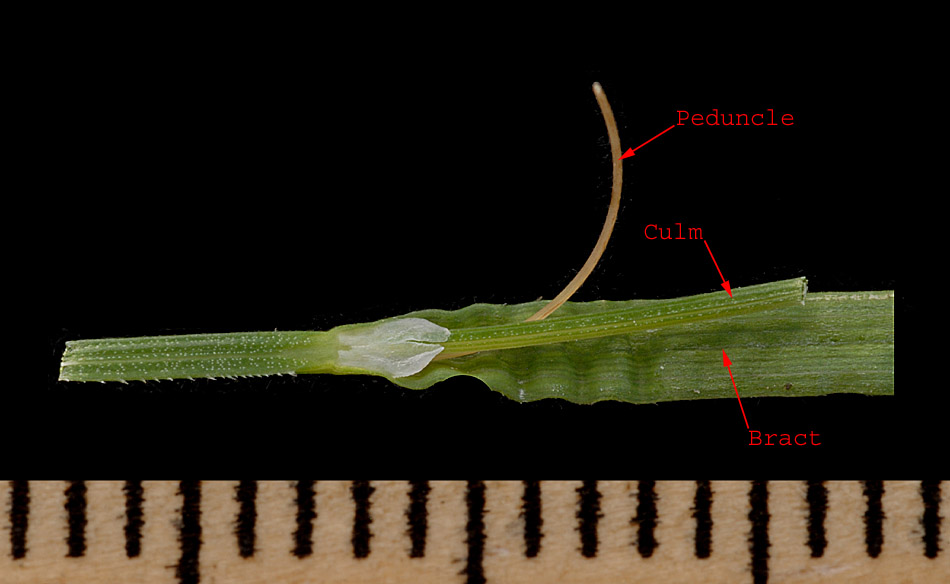 |
Stigmas 3; achenes three-sided,
occasionally terete, though their shape may be concealed by flattened
perigynia. NOT [stigmas 2; achenes lenticular] |
 |
Spikes 2 or more per culm, terminal and
lateral; spike bracts present on lateral spikes (except in Section Phyllostachyae),
lowest bract usually evident, often conspicuous. NOT [Spikes 1 per
culm, terminal; spike bracts absent]. |
 |
Lower pistillate scales not bract-like or
leaf-like but similar in size and shape to individual perigynia (up to
twice as long as perigynia in C. magellanica ssp. irrigua).
NOT [Lower pistillate scales resembling green, leaf-like bracts much
longer and wider than individual perigynia] |
 |
Perigynia glabrous. NOT [Perigynia
sparsely to densely pubescent or puberulent (in C. pedunculata
pubescence represented by very short hairs scattered near tip; in some
species of Sect. Acrocystis, perigynia may be glabrous or
virtually hairless, but all members of this group have convexly 3-sided
to terete achenes with tight fitting perigynia and a stipe-like base
about equal to beak in length)] |
 |
Beak absent or less than 0.5 mm long; if
more than 0.5 mm long, then terminating in an orifice without teeth. NOT
[Beak over 0.5 mm long and usually visibly bidentate (teeth hyaline in C.
sprengelii, inconspicuous in C. viridula, very short in C.
oligosperma).] |
 |
Leaves and sheaths glabrous; plants
cespitose or rhizomatous. NOT [Leaves and sheaths pubescent; plants
cespitose] |
 |
Lowest spike bracts sheathless or with
sheaths 1-2 mm long (to 3 or 4 mm long in Section Limosae).
NOT [Lowest spike bract sheath at least (2.5) 3 mm long] |
 |
Plants cespitose or rhizomatous, usually
taller than 2 dm (to 8 dm); terminal spike if staminate then wider than
2 mm or longer than 1 cm, or pistillate spikes long-stalked; leaves 1-6
mm wide; plants of boreal forest and grassland habitats. NOT [Plants
densely tufted and low, usually less than 2 dm tall; terminal spike
staminate (occasionally with a few pistillate flowers at base in C.
glacialis), 1-2 mm wide and seldom over 1 cm long; pistillate spikes
sessile or slightly stalked; leaves 0.4-1.5 mm wide; plants of rocky
and/or sandy habitats in far north.] |
 |
Lateral spikes on filiform stalks 0.5 cm
long or longer, often nodding. NOT [Lateral spikes sessile or
erect on short stalks.] |
 |
Terminal spike almost always staminate
(occasionally gynecandrous in C. magellanica ssp. irrigua),
distinctly narrower than lateral pistillate spikes; beak absent or less
than 0.5 mm long, merely a hole or short tube or cone with no teeth;
roots with a felt-like covering of yellowish pubescence. NOT
[Terminal spike gynecandrous, not distinctly different in appearance
from lateral pistillate spikes except for a V-shaped base consisting of
staminate flowers; beak 0.4-0.5 mm long, bidenticulate; roots lacking
felt-like covering of yellowish pubescence. |
 |
Pistillate scales 1.2-2 mm wide, narrower
and longer than perigynia (at least those at base of spike), either
long-tapering or with awns 1.5-3 mm long; NOT [Pistillate scales 2-2.5
(3.4) mm wide, wider and about same length as perigynia, occasionally
mucronate with a point less than 1.5 mm long.] |

